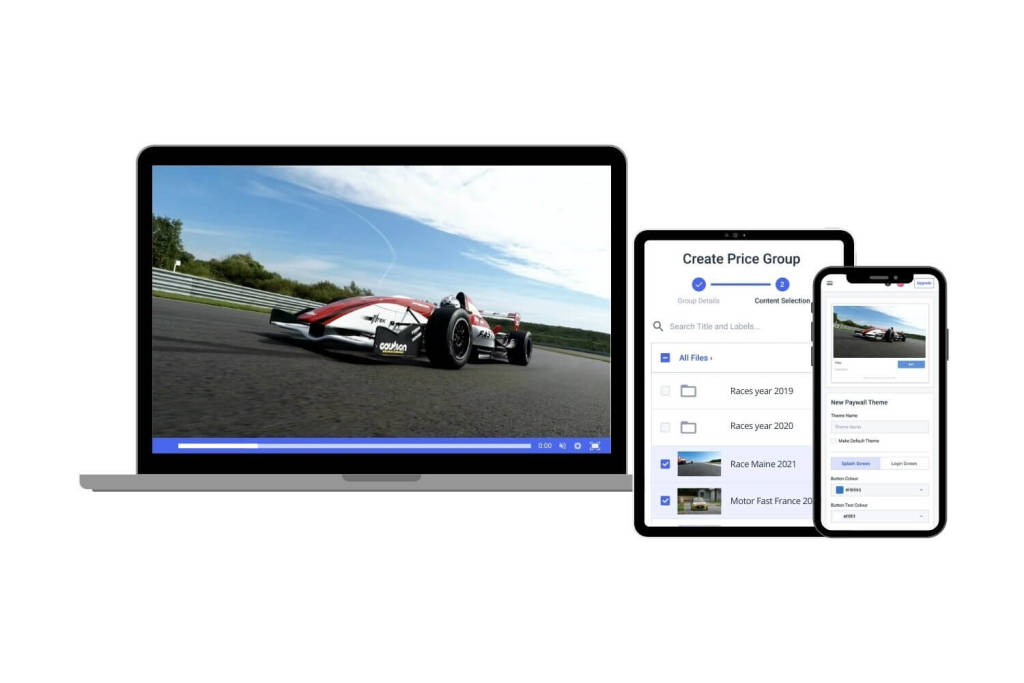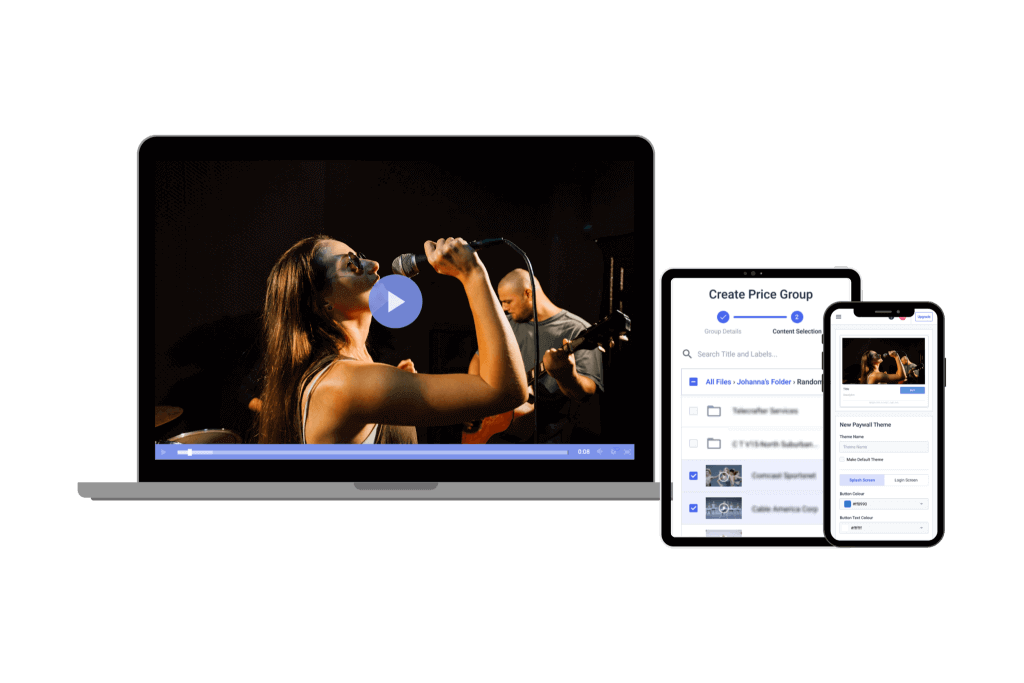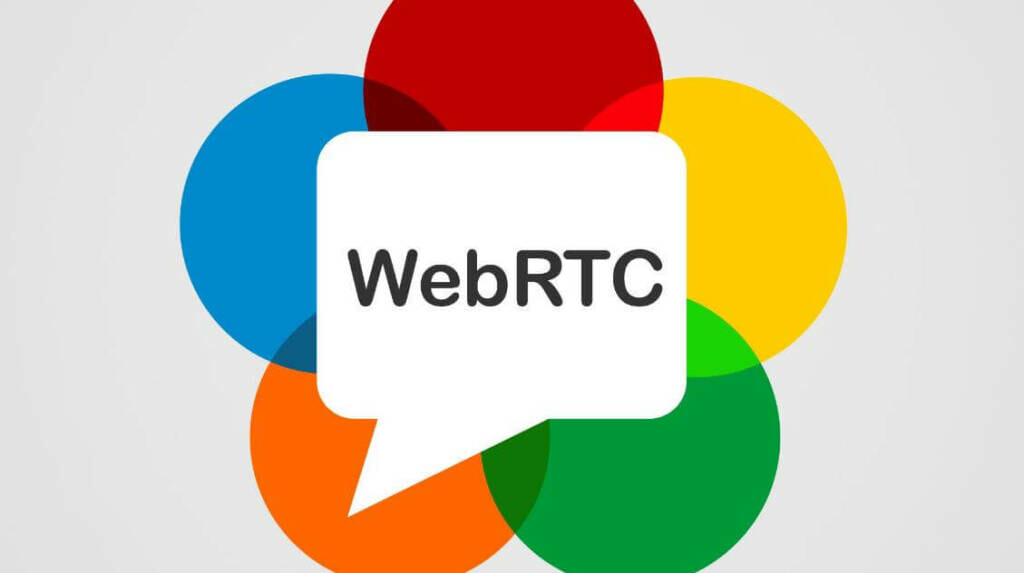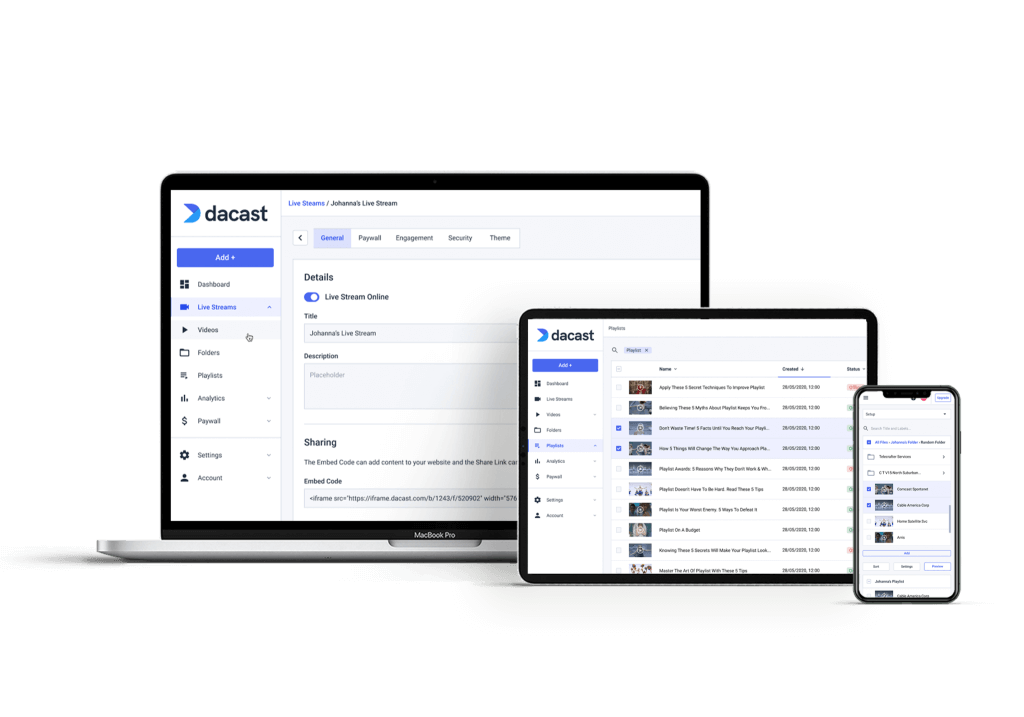RTMP vs. HLS vs. WebRTC: Comparing the Best Protocols for Live Streaming
Live streaming technology has made leaps and bounds in the past few years. Thanks to these developments, it’s possible for broadcasters with little to no technical knowledge to produce high-quality streams.
One of the most important types of technology that works behind the scenes to deliver video files over the internet in real-time is streaming protocols. While there are many different protocols that work together to bring the streams to life, there are three protocols that are very prominent in the current online streaming scene, including RTMP, HLS, and WebRTC.
In this post, we’re going to compare RTMP, HLS, and WebRTC. We will establish the differences and similarities between RTMP vs HLS vs WebRTC. We will discuss the roles of each of these streaming protocols in live streaming platforms. In particular, we will discuss options for low latency streaming.
Table of Contents
- What is a Streaming Protocol?
- What is RTMP?
- What is HLS?
- What is WebRTC?
- Comparing RTMP vs. HLS vs. WebRTC
- Which Streaming Protocol Should You Use?
- Latest Protocol Developments
- AI and Machine Learning Advances
- Leveraging Live Streaming Protocols for Businesses
- Streaming Protocols on Dacast
- The Future of Streaming Protocols
- FAQs
- Conclusion
What is a Streaming Protocol?


A video streaming protocol is a standardized delivery method that is used to break up a video into chunks, transport it, and reassemble it.
Since video files are notoriously bulky, transporting them requires a highly technical setup. There are many “stops” on a video’s journey from the source to the user-facing video player, and streaming protocols are what bring the video from one stop to the next.
Different protocols are developed by different companies and organizations to serve unique purposes in online video streaming. They are typically standardized and/or open-source so that they can be used seamlessly with different technology and streaming setups.
Some of the most popular streaming protocols include RTMP, HLS, and WebRTC. You will often see these streaming protocols compared against each other, with comparisons such as WebRTC vs HLS and WebRTC vs RTMP commonplace. (paragraph break)
Let’s take a closer look at each of these protocols. This will give you a better understanding of how they work and the purpose that they serve.
What is RTMP?
Real-Time Messaging Protocol (RTMP) is a streaming protocol that was originally used to deliver video content to Adobe’s Flash player. This protocol is known for its capability to provide low-latency streaming.
Since Flash is dead, many people assume that RTMP is also dead, but this is not the case. RTMP has taken a new role in live streaming. It is now used for ingesting media from the encoder or other source to an RTMP -enabled streaming platform.
There are many perks of using RTMP for the ingestion of video feeds. For starters, it is currently the most accessible and affordable option since it works with most modern encoders, including many free encoding software. It is also capable of low-latency streaming, which is another major benefit for broadcasters.
There are several variations of RTMP that serve slightly different purposes. (change formatting)
- RTMPS, or Real-Time Messaging Protocol Secure, is RTMP with an added layer of security, and it is primarily used for streaming over public networks.
- RTMPE is the variation of RTMP with an added layer of encryption.
- RTMPT is a special variation that is suited for bypassing firewalls.
Unfortunately, RTMP is not compatible with more modern video players, including HTML5, so it is no longer used for delivery in any streaming setups. However, it is very effective in its ingestion role, so it is quite valuable in streaming. As with many types of technology, the role of RTMP continues to change.
What is HLS?


HTTPS Live Streaming (HLS) is a protocol that was developed by Apple for streaming with an HTML5 video player.
To clarify, HLS delivery to the HTML5 video player has replaced RTMP delivery to the Adobe Flash player.
HLS is absolutely essential in most modern streaming setups since the HTML5 video player is the only type of universally compatible video player. Since HTML5 video players come with so many benefits, most broadcasters consider it the only viable option.
Since HLS works with an HTML5 video player, it is capable of streaming to just about any internet-enabled device.
Other than its ultra-compatibility, HLS has several other remarkable perks. HLS is very secure, and it produces high-quality streams.
This protocol also supports adaptive bitrate streaming, which is very important at the professional broadcasting level. In addition to being adaptive, HLS is also dynamic. That means that at any given moment, the bitrate of each individual viewer’s stream will adjust to best suit the connection conditions.
HLS can be used for both delivery and ingest, but it is currently more prominent for delivery since it is not widely compatible with most encoders.
It is also important to point out one major downfall of HLS: when used alone, it causes a latency of 15-30 seconds, which means that the HLS delivery/HLS ingest combination is not capable of streaming with latency as low as some as other setups.
What is WebRTC?


Web Real-Time Communication (WebRTC) is a streaming project that was created to support web conferencing and VoIP. It was purchased by Google and further developed to make peer-to-peer streaming with real-time latency possible.
WebRTC is an open-source project, which makes it possible for developers to use the technology to incorporate streaming in their software.
Although WebRTC is technically a project, it is typically lumped in with protocols since their functionality is very similar.
WebRTC has become very important since the start of the pandemic when streaming with real-time latency has been essential to keeping some semblance of normal throughout many industries. Video conferencing made it possible for many businesses and schools to keep running when in-person meetings were simply not possible.
Currently, WebRTC supports Google Meet, which is a web conferencing tool from Google. It is also used by other popular tools with video conferencing features, such as Slack, Whatsapp, Discord, and Snapchat.
Aside from streaming with real-time latency, WebRTC is very secure. It is encrypted with SRTP and other gold-standard security measures. Like HLS, WebRTC is capable of adaptive bitrate streaming, so you can deliver multiple renditions of your stream with the optimal quality for each viewer.
WebRTC is also known for its customizability and adaptability. It is also capable of streaming to most browsers and types of devices. The combination of these features makes WebRTC a great choice.
Comparing RTMP vs. HLS vs. WebRTC
RTMP, HLS, and WebRTC each have unique roles in live streaming. What they all have in common is that they help transmit data in real-time or as close to real-time as possible. As such, you will often see comparisons of WebRTC vs RTMP or WebRTC vs HLS.
Although you know what each technology does, you’re probably left wondering which is the best for live streaming. The answer? It depends.
Different circumstances call for unique streaming setups and protocols. Currently, HLS delivery with RTMP ingest is the chosen combination in many streaming setups. That is because it ticks the boxes of low latency, ultra-compatibility, and affordability.
HLS delivery can be used with HLS ingest, but there is no widespread support for HLS ingest among encoders and related technology.
When it comes to affordability, it isn’t that the protocols themselves cost more or less. It is the availability and affordability of the equipment that is compatible with each protocol or setup.
WebRTC, on the other hand, is becoming more and more popular. However, it still faces one major limitation: it is not widely supported by most encoders. The same goes for other streaming software, like production and mixing tools.
While this major limitation of WebRTC can be overlooked in peer-to-peer streaming setups that use a digital webcam to capture the video, it poses major issues for broadcasting at the professional level.
Until more encoders and related technology support WebRTC and HLS, the HLS delivery/RTMP ingest combination will likely remain the preferred streaming set-up in the professional broadcasting arena.
With WebRTC vs HLS, HLS is more popular for professional broadcasting needs. With WebRTC vs RTMP, it is important to understand that HLS works together with RTMP, so there is no direct WebRTC vs RTMP.
Also, it is worth noting that these protocols are just a few of many available. RTSP and variants of RTMP are also commonly used in streaming. These typically add a slightly different functionality which makes them better suited for different use cases.
Technical Comparison
In-Depth Architecture and Performance Metrics
RTMP (Real-Time Messaging Protocol), HLS (HTTP Live Streaming), and WebRTC (Web Real-Time Communication) follow distinct data paths from ingestion to delivery.


- RTMP: Used primarily for ingesting live streams, RTMP transmits data between an encoder and a media server like Nginx with RTMP module. It requires a streaming server (e.g., Wowza or Dacast) to repackage the stream into HLS for broad device support.
- HLS: Works via HTTP-based chunked transmission. A media server segments the stream into small video chunks and delivers them via a content delivery netwrk (CDN), making it highly scalable.
- WebRTC: Designed for real-time, peer-to-peer communication, WebRTC eliminates the need for intermediary servers in many cases, offering ultra-low latency.
Performance Metrics
- Latency: RTMP (2-5s), HLS (10-30s, but LL-HLS can reduce it to 2-3s), WebRTC (<1s)
- Error Handling: RTMP retries failed packets, HLS uses segment-based redundancy, WebRTC employs Forward Error Correction (FEC) for stability.
- Recovery: HLS benefits from CDN caching, RTMP re-establishes connections quickly, WebRTC dynamically adjusts streams based on network conditions.
Security Enhancements
Security is critical for protecting live streams from piracy, unauthorized access, and data breaches. Each protocol has unique security measures:
- RTMP & RTMPS: While standard RTMP lacks encryption, RTMPS (RTMP over SSL/TLS) ensures secure ingestion. Platforms using Nginx RTMP can support RTMPS for improved security.
- HLS: Uses AES-128 encryption to protect content and secure token authentication to restrict unauthorized playback. Advanced implementations leverage DRM (Digital Rights Management) for premium content protection.
- WebRTC: Offers end-to-end encryption by default using DTLS-SRTP. This makes it a preferred choice for secure, real-time communications.
Emerging Security Standards
- Zero Trust Authentication: Prevents unauthorized stream access through continuous verification mechanisms.
- AI-Powered Fraud Detection: Identifies anomalies in viewing patterns to detect and block piracy attempts.
- Enhanced LL-HLS Encryption: Future advancements in LL-HLS will improve DRM support while maintaining low latency.
Understanding the strengths of RTMP vs. HLS vs. WebRTC helps broadcasters choose the right protocol for their needs. Whether focusing on latency, security, or scalability, platforms like Dacast support all three to deliver optimal streaming experiences in 2025.
Which of these Streaming Protocol Should You Use?
Choosing the right streaming protocol depends on your specific use case and requirements:
- RTMP is ideal for ingestion, particularly for live streams that need low latency from the encoder to the streaming server. It’s compatible with most encoders and cost-effective.
- HLS is the best choice for delivery, offering broad device compatibility and adaptive bitrate streaming for a smoother viewer experience. However, it may have higher latency compared to other protocols.
- WebRTC is perfect for real-time communication, such as video conferencing or interactive streams, as it provides ultra-low latency and peer-to-peer capabilities. However, it lacks widespread encoder support, making it less suitable for large-scale professional broadcasts.
For professional broadcasting, combining RTMP for ingestion with HLS for delivery is a common approach, offering a balance of low latency and wide compatibility. For real-time, interactive experiences, WebRTC is the preferred protocol.
Latest Protocol Developments
As of 2025, among the protocols mentioned above, there have been some recent developments in the world of protocols.
Low-Latency HLS (LL-HLS)
Traditional HLS streaming typically comes with a latency of 15–30 seconds, which is not ideal for real-time interactions. However, Low-Latency HLS (LL-HLS) has introduced improvements that bring latency down to 2–5 seconds, making it a strong competitor to WebRTC. By using chunked transfer encoding and reducing segment sizes, LL-HLS enables faster data delivery while maintaining the adaptive bitrate capabilities of standard HLS. This innovation helps businesses and broadcasters looking for a balance between scalability and interactivity, especially in sports streaming and live events.
CMAF (Common Media Application Format)
CMAF is an evolving standard designed to unify media packaging across different streaming protocols, particularly HLS and DASH. By enabling a single format for both, CMAF reduces the need for separate encoding and storage processes. This not only simplifies workflows but also minimizes latency by allowing lower segment durations. Broadcasters using RTMP to WebRTC, HLS to WebRTC, or other combinations can benefit from more efficient delivery and reduced delays, making CMAF an essential development for the future of streaming.
SRT (Secure Reliable Transport)
SRT is gaining traction as a secure, low-latency alternative to traditional streaming protocols like RTMP and HLS. Unlike RTMP, which relies on outdated technology and is being phased out by many platforms, SRT offers end-to-end encryption and adaptive error correction, making it ideal for unpredictable network conditions. Professional broadcasters increasingly prefer SRT for remote contribution and high-quality live streaming, positioning it as a strong contender in the ongoing WebRTC vs RTMP vs HLS debate.
As the streaming landscape continues to evolve, businesses must consider innovations like LL-HLS, CMAF, and SRT when choosing the right protocol. Whether optimizing a real-time broadcast or ensuring scalable content delivery, these advancements play a key role in shaping the future of live streaming.
AI and Machine Learning Advances
Adaptive Streaming Enhanced by AI
AI-driven algorithms are changing the way streaming protocols like RTMP, HLS, and WebRTC handle video delivery. These smart systems predict network conditions and automatically adjust bitrate, transcoding, and error correction to optimize the viewer’s experience in real time. Whether streaming through an RTMP server, using WebRTC live streaming broadcast, or delivering HLS content, AI ensures smooth playback by adapting to fluctuations in bandwidth. Technologies like NGINX with the RTMP module also benefit from AI-powered enhancements to improve stream reliability.
Quality and Performance Optimization
Machine learning models are now integrated into streaming workflows to improve quality and performance. They monitor latency, detect anomalies, and predict server load before issues arise. Whether using WebRTC broadcast streaming, HLS RTMP workflows, or transitioning from RTMP to HLS, AI helps reduce buffering and enhance stream efficiency. AI-driven analytics also optimize encoding settings in real time, ensuring a seamless experience for audiences watching via WebRTC vs. HLS or RTMP HLS setups.
Content Personalization and Security
AI is also advancing content personalization and security in live streaming. Platforms supporting RTMP vs WebRTC or HLS vs RTMPS leverage AI for real-time content moderation, dynamic ad insertion, and AI-based watermarking to protect intellectual property. Security improvements extend to RTSP vs WebRTC, WebRTC vs RTSP, and HLS WebRTC workflows, where AI-powered threat detection helps prevent unauthorized access. These advancements ensure businesses and broadcasters can deliver secure, personalized experiences while using protocols like RTMP vs RTSP or HLS vs WebRTC for live video streaming.
Leveraging Live Streaming Protocols for Businesses
Detailed Pros and Cons Comparison for Enterprises
When choosing a live streaming protocol, businesses must consider factors like scalability, cost, compatibility, security, and ease of integration. Below is a comparison of RTMP, HLS, and WebRTC:
Aspect | RTMP | HLS | WebRTC |
|---|---|---|---|
Scalability | Limited; best for smaller audiences. | Highly scalable; suitable for large audiences. | Limited; ideal for peer-to-peer or small group communications. |
Cost | Lower infrastructure costs; requires dedicated media servers. | Moderate; can leverage existing HTTP infrastructure. | Higher; demands robust infrastructure for real-time data transmission. |
Compatibility | Legacy support; not natively supported on iOS devices. | Broad support across devices and browsers. | Supported by major browsers; may require additional setup for some devices. |
Security | Basic encryption; less secure than modern protocols. | Supports DRM and HTTPS; offers enhanced security. | Secure by design; encryption is mandatory. |
Ease of Integration | Requires media servers like NGINX with RTMP module. | Easy integration with standard web servers and CDNs. | Complex; involves handling NAT traversal and firewall issues. |
Case Studies and Use Cases
Here are some use cases that serve as examples of how businesses have leveraged live streaming protocols. Use these to help guide your decision using the right protocols for your business needs.
Enterprise Live Events: A multinational corporation used RTMP for ingesting live video feeds into their streaming platform. They then employed Low-Latency HLS (LL-HLS) for content delivery to ensure a scalable and smooth viewing experience for a global audience. For interactive Q&A sessions, WebRTC was integrated to facilitate real-time communication between presenters and viewers.
Telehealth Services: A healthcare provider implemented WebRTC to enable real-time video consultations between doctors and patients. For broadcasting medical webinars to a larger audience, they utilized HLS to ensure compatibility across various devices and maintain stream quality.
Cost and Infrastructure Considerations
- RTMP: While RTMP’s infrastructure costs are relatively low, it necessitates dedicated media servers, such as NGINX with the RTMP module, which can add complexity to the setup.
- HLS: HLS can leverage existing HTTP infrastructure and CDNs, making it cost-effective for large-scale streaming. However, latency issues might require investment in Low-Latency HLS solutions.
- WebRTC: Implementing WebRTC can be costly due to the need for robust infrastructure to handle real-time data transmission and NAT traversal. Despite this, its peer-to-peer nature can reduce server bandwidth costs for direct communications.
Selecting the appropriate streaming protocol depends on the specific needs of the business, including audience size, desired latency, budget, and technical capabilities.
Streaming Protocols on Dacast


Dacast strives to provide a professional live streaming experience via an HTML5 video player. Two major goals of the Dacast platform are low-latency streaming and ultra-compatibility.
In order to achieve these two goals, Dacast uses a default configuration of HLS delivery with RTMP ingest.
Dacast also supports an HLS delivery and HLS ingest setup. This streaming setup supports streaming to users on all sorts of devices, but as we discussed before, HLS is not widely compatible with most video encoders. It’s also important to note that this combination is not capable of the low-latency streaming that the HLS delivery/RTMP ingest combination.
Dacast now supports WebRTC streaming as well, giving broadcasters more options to reach their audience. Our team is always working to further develop our software whenever new streaming technology enters the conversation.
The Future of Streaming Protocols
Forward-Looking Trends
Streaming protocols will evolve with 5G, 6G, and edge computing, reducing latency and improving quality. These advancements will allow WebRTC, RTMP, and HLS to adapt to new demands, with AI-driven adaptive bitrate streaming enhancing performance across different network conditions. LL-HLS continues to strengthen HLS in the “WebRTC vs HLS” debate, providing lower latency and higher efficiency for large-scale streaming. Meanwhile, secure protocols like RTMPS are improving data protection, making them increasingly relevant for enterprise-level security needs.
Future developments may introduce AI-powered models capable of dynamically switching between WebRTC, HLS, and RTMP based on real-time network and device conditions. This will ensure seamless streaming experiences by automatically selecting the most efficient protocol. As streaming traffic grows, intelligent automation and machine learning will play a crucial role in optimizing bandwidth, reducing buffering, and enhancing video quality across all devices.
Hybrid Solutions and Convergence
Businesses are increasingly adopting hybrid streaming solutions, combining WebRTC HLS for low latency and broad compatibility or HLS RTMP for stability and scalability. Hybrid models allow content providers to deliver high-quality streams across various devices while optimizing performance based on audience needs. Multi-protocol streaming is becoming the standard, with WebRTC supporting real-time interaction while HLS and RTMP ensure reliable large-scale content delivery.
With AI-driven protocol switching, streaming platforms will become more efficient in adjusting to network changes, ensuring smooth playback regardless of connection speed or device limitations. This convergence of technologies will drive the future of live streaming, allowing businesses to deliver highly responsive and scalable solutions. As streaming continues to evolve, the integration of edge computing, adaptive bitrate technology, and automated protocol selection will be key to meeting the growing demand for seamless and high-quality content delivery.
FAQs
1. What is the RTMP streaming protocol?
The RTMP streaming protocol, or Real-Time Messaging Protocol, is used to transmit audio, video, and data from an encoder to a server for live streaming. Originally developed for Flash, RTMP is now primarily used for ingestion due to its low latency. It is widely compatible with streaming encoders, making it a popular choice for live broadcasts.
2. What is the HLS streaming protocol?
The HLS (HTTP Live Streaming) protocol, developed by Apple, is used for delivering video content over the internet. It breaks video into smaller segments and uses an HTML5 video player, making it highly compatible with a wide range of devices. HLS also supports adaptive bitrate streaming, providing viewers with the best quality based on their network conditions.
3. What is the WebRTC streaming protocol?
WebRTC (Web Real-Time Communication) is an open-source project that enables real-time, peer-to-peer video and audio communication over the internet. It provides ultra-low latency, making it ideal for live interactive experiences like video conferencing. WebRTC is browser-compatible and widely used in applications like Google Meet and WhatsApp.
4. How do I choose between RTMP and HLS for streaming?
Choose RTMP if you need a reliable protocol for ingesting live streams with low latency, as it’s compatible with most encoders. Use HLS for delivering streams to a wide range of devices, as it offers adaptive bitrate streaming and greater compatibility, but with slightly higher latency. A combination of RTMP for ingest and HLS for delivery is often ideal for professional broadcasts.
5. Why would I choose WebRTC instead?
You would choose WebRTC if you need real-time, peer-to-peer communication with ultra-low latency, ideal for interactive experiences like video conferencing or live online meetings. It enables direct streaming without a server in between, providing instantaneous communication and a smooth, responsive experience. WebRTC is also compatible with most browsers, making it accessible for web-based applications.
6. What is the lowest latency protocol for live streaming?
The lowest latency protocol for live streaming is WebRTC, providing real-time communication with minimal delay, ideal for interactive applications like video conferencing. It enables direct peer-to-peer connections without a server intermediary. WebRTC’s ultra-low latency makes it the fastest option for live streaming.
Conclusion
Streaming protocols are essential for live streaming over the internet. When you choose a professional video hosting platform, it is important to make sure that your chosen software uses protocols that are compatible with the rest of your streaming setup.
The bottom line is that the HLS delivery/RTMP ingest combination is currently the best way to go. Once supporting technology, like encoders and other software, evolves to support more protocols for ingest, the roles of HLS and WebRTC will shift.
If you are looking for a powerful video hosting platform that is capable of low-latency streaming, Dacast could be a great option for you. Our platform supports live streaming and on-demand video hosting and includes access to tools for video monetization, white-label streaming, an HTML5 video player, cloud transcoding, and more.
We invite you to take advantage of our 14-day risk-free trial. You can access all of our professional streaming features to see how our platform can help you reach your streaming goals.
Sign up today to get started in minutes. No credit card is required.
If you want to learn more about RTMP, HLS, WebRTC, and other streaming protocols, we recommend checking out the Knowledgebase section of our site. A quick search for “streaming protocols,” “RTMP,” or other related keywords will generate documentation that provides more insight on these topics.
For regular live streaming tips and exclusive offers, you can join the Dacast LinkedIn group.


